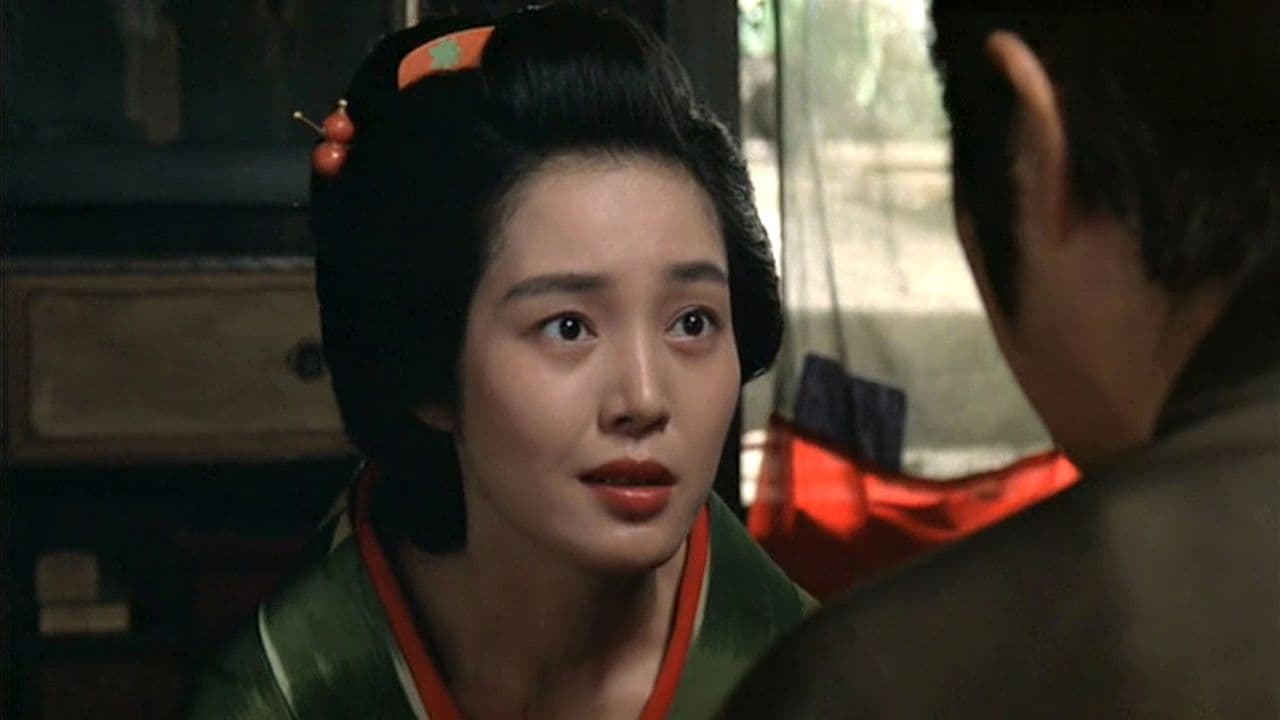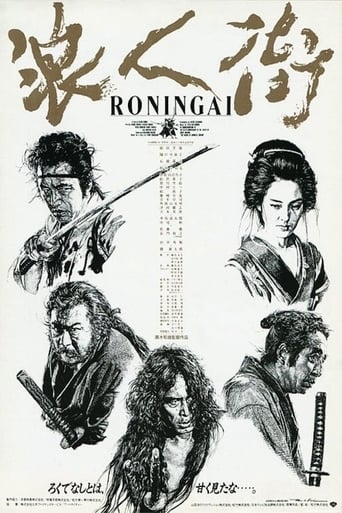WillSushyMedia
This movie was so-so. It had it's moments, but wasn't the greatest.
Ketrivie
It isn't all that great, actually. Really cheesy and very predicable of how certain scenes are gonna turn play out. However, I guess that's the charm of it all, because I would consider this one of my guilty pleasures.
Raymond Sierra
The film may be flawed, but its message is not.
Cassandra
Story: It's very simple but honestly that is fine.
lchadbou-326-26592
Street Of The Masterless Samurai is a standard samurai saga, rather different from the previous film I'd seen by its director, the interesting 1966 documentary, Silence Has No Wings. It opens with swordplay in the rain and climaxes with the violent spectacle of a small group of ronin coming to the aid of a whore in the forest, grotesquely held down between two bulls who are about to tear her apart. (Is this the Japanese equivalent of the melodramatic heroine tied to the railroad tracks?)One of them is even got up in full body armor and riding a horse. In between though there is little action, as the ronin who linger in a countryside roadhouse can't rise to the challenge of a sinister entourage of samurai who dress up at night masked in blue (almost like the KKK!) to terrorize several local women who are struggling to make ends meet as prostitutes.The setting is 1836, during the last decades of an apparently corrupt Shogunate.The most vividly etched of these tavern characters is "Bull," a yojimbo or bouncer, who appears burly and tough but later instead of fighting the arrogant samurai that he looks like he's going to duel, sells himself to them out of desperation and even degrades himself by crouching like a dog and retrieving a sandal for one. In the end he will redeem himself by committing suicide and bringing down his boss with him. This character,by turns comic, pathetic, and tragic, is played in his last screen role by Shin Katsu, famous for his earlier Zatoichi vehicles,and even if the film isn't all it could be, it's worth seeing for his acting.
kuuzo
This is a character driven movie in which the plot is only corollary to the actual story of a group of characters thrown together in a small town. The marginal plot involves retainers of the Shogun killing prostitutes, but what make this a memorable movie are the characters: 'Bull' - a belligerent drunken bouncer for a drinking establishment who is the spitting image (in spirit) of Toshiro Mifune - 'Aramaki' - an uncouth and dirty ronin and pimp who looks like a Japanese Benicio Del Toro - Oshin - a prostitute and barmaid - Sakichi - who is a former vassal of the local lord who sells birds for a living, and smells eternally of bird droppings, and Horo - who makes his living testing swords on dead convicts. I recommend it if you are tired of the typical range of Samurai movies, and just want an entertaining, well acted drama that just happens to have Samurai with cutting instruments.
nebbs
With a storyline that has so much promise, and as a tribute to the father of its genre (chambera/jidai-geki), I found this version of Ronin Gai to be both weak and disappointing. The editing and camera-work were dull, close-ups that were cried out for failed to materialize, the incidental music was irrelevant, and characterizations while promising, never attained their potential. The director was supposedly inspired to become such by Kurosawa's work, but aside from a few half-hearted rip-offs there is absolutely nothing of that great director's magic here. This is a bland samurai film in the extreme, and very disappointing.
FilmFlaneur
(Some spoilers)Kuroki's 1990 version of Rônin-gai (aka: Street Of The Masterless Samurai) is the fourth film with this name to appear since the 1920s and is generally taken as one of this director's best films, although he is not a name widely known in the west. Rônin-gai was made in commemoration of the death of Shozo Makino, a pioneer of early Nipponese cinema. Again largely unknown to occidentals, Makino is credited with virtually creating the Japanese period film. Kuroki's film is an apt tribute, as it is both an interesting contribution to the 'chambera', or swordplay, genre as well as presenting memorable portraits of several flawed characters.Set in the transitional historical period between the Japanese feudal era and the impending Meji Restoration (when the country was more and more opened up to the west) Rônin-gai concerns a disparate group based around an eating house/brothel on the outskirts of Edo. As the film starts, Aramaki Gennai, a wild haired, unstable ronin, played by Yoshio Harada and reminiscent of Toshiro Mifune's Kikuchiyo from The Seven Samurai, arrives and drunkenly tries to take up again with high-priced prostitute Oshin (Kanako Higuchi). At the same time she is the object of desire for another ronin, Horo (Renji Ishibashi), and has a further protector in the form of 'Bull' a stocky bouncer at the eatery, in general charge of the whores who congregate there. Close by, another displaced warrior Doi ekes out a humiliating existence as a miserable bird breeder with his sister, and dreams of rejoining his clan. While this assortment of social misfits and outcasts contemplate their decline, a group of murderous samurai begin paying the community attention.Apparently inspired to choose film making as a career by the work of Kurosawa, Kazuo reveals the influence of the older master in this film by showing a similar attention to historical detail, an interest in characterisation, as well as a storyline with humanistic undertones. As the film begins we are confronted by a motley group of prostitutes, drunkards and pitiful ronin, self-pitying and unlikeable. This is a society patently caught between the social regimentation of the previous centuries, where all knew their place, and the breakdowns of coming liberalisation. Those who are stranded between the two worlds are disillusioned and dissatisfied, while the erstwhile respectable caste of still-employed samurai turn out to be murderers and fanatics.Kazuo's achievement is to convey his unlikely heroes' ultimate nobility, as they are stirred to fight the samurai who prey on them. (In a way this is an ironic reversal of The Seven Samurai scenario, where brave ronin are hired to defeat bandits.) Thus while we see Oshin as initially frivolous, and Gennai a drunkard insensitive to the killings it is he who launches the first, and most impressive fight back. While Gombei is emasculated in his secret admiration for Oshin, and as a result of it faces humiliation, he acquires pride and purpose in defence of her. When the gruff Bull abandons his pride and sells his soul to the samurai, in the most shameless moral regression of all, he acts more like a dog than a man. His final act, though fortified with drink, is more honourable. Doi, who has actually managed to earn a living, starts out bitter, obsessed with purchasing his return to favour with the clan. He condemns his supportive sister while dreaming of recovering his station and obtains the money he needs by shameful means. By the end of the film, although slightly absurd in his actions (Don Quixote briefly springs to mind as he belatedly armours up) Doi, too, has gained something back.Rônin-gai depicts a society that is seeing the degrading of social bonds and responsibilities that have stood for centuries, a sense of confusion conveyed well in the opening scenes. This is not the wild disorientation of a film like Ran however - rather the gradual erosion of bonds and honour at the end of an era. For a while at the start it is hard to discover who owns fealty to whom, as a samurai is killed in the rain, seen in long shot so that signs of rank are hard to see and has his sword stolen, while Aramaki picks a drunken argument with Bull. We barely hear of the central Shogunate power, responsible for the rogue samurai who are causing the murders (although it does step in at the end, we are told, to punish the guilty). Like Oshin at the point of being torn apart by bulls as part of the rogue samurais' cruelty, this Japan risks dislocation. One wonders if the upheavals of the modern country, as the 'economic miracle' slowed down, had a role to play in the choice of subject.Kuroki's film was his last for a decade (Pickpocket followed in 2000) and in many ways it was a good project with which to signal a creative pause. By explicitly honouring the cinematic past as well as implicitly incorporating the insecurities of the present into a single project, he gives a familiar plot new life while creating an excellent work its own right. To those who just wish to enjoy some excellent sword fighting this can be recommended too, although it principally occurs at the end.

